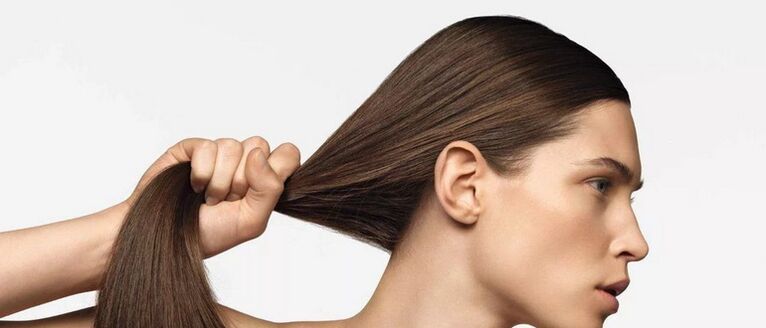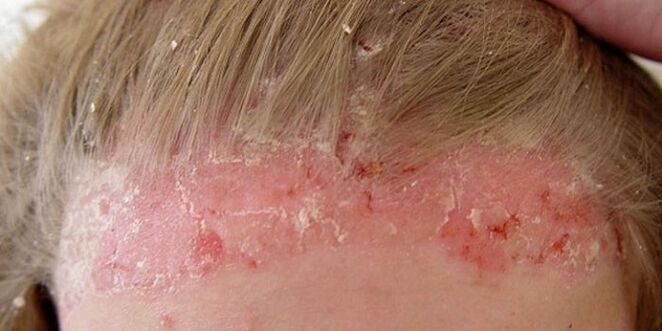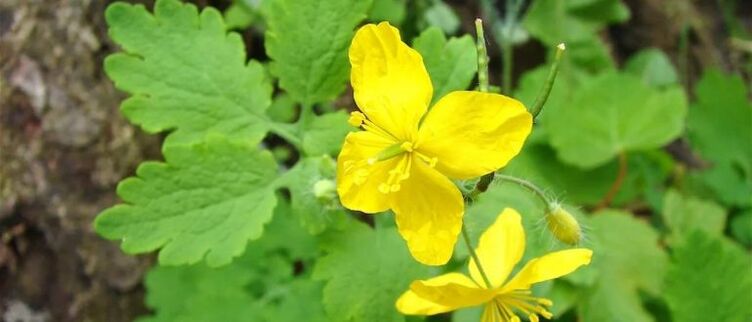Psoriasis on the head significantly reduces the quality of human life and requires a lot of effort and money for treatment. The constant struggle with the symptoms of psoriasis and the feeling that you are not like everyone else creates a special psychological problem. This burden is especially heavy for young people who do not yet have a family of their own. After all, people around you often accept shaving for head lice or think that a person is dirty. In fact, lichen scales are not contagious and occur mainly as an inherited disease.
Causes
Scalp psoriasis occurs in children and adults. Its appearance, as current, is unpredictable. Scientists still do not understand why and for what specific reason psoriatic rash appears on the human body and affects the scalp. Before the appearance of psoriasis in the head and other parts of the body, they were able to determine the dysfunction of the epidermis. This happens to the skin after exposure to external irritants, such as using a low-quality shampoo or body gel.
It was later found that many factors contribute to the development of psoriasis, for example:
- malnutrition;
- alcohol abuse;
- infectious skin diseases;
- general intoxication of the body;
- hormonal imbalance;
- endocrine disorders;
- weakening of immunity;
- allergic reactions.
This is not a complete list of things that can affect the severity of scalp disease.

Psoriatic elements on the scalp, as in other localizations, are formed in the upper layer of the epidermis, and therefore rarely disrupt the growth of individual hairs and cause their loss.
If you look at it, all these and other causal factors, which are not mentioned here, have one thing in common - the ability to adversely affect metabolic processes in the skin. However, this is one of the main reasons for the abnormal proliferation of epidermal cells.
Symptoms of various diseases
Initially, the following forms of psoriasis can occur:
- Vulgar - another name for plaque psoriasis, diagnosed in 90% of cases. It is characterized by the appearance of small papules and red spots on the scalp. Their surface is covered with dry silver scales that can be easily removed with nails. The elements of the spill gradually increase, then merge into one and represent the islands with a scaly gray surface.
- Pustular - exudative psoriasis, which is considered the most serious form of the disease, manifests itself in small blisters with yellow or transparent content. The skin under the skin swells and becomes warm. If left untreated, ulcers from open bubbles can become infected with a bacterial infection.
- In the form of drops - develops against the background of streptococcal infection. The elements of the rash are in the form of a hernia and tend to grow.
What psoriasis looks like at first in different stages
In the early stages of psoriasis, there are symptoms similar to most other dermatoses (common dandruff, seborrheic dermatitis, etc. ). Therefore, only a specialist can correctly diagnose the disease in order to choose the most effective course of treatment.
The following pathological changes are observed on the scalp at each stage of psoriasis development:
- A small, itchy, papular rash appears. Its elements are rounded and red or pink. A characteristic feature of psoriatic eruptions at this stage is the formation of crusty silver coins on their surface when combed. There is no inflammatory process, so the psoriasis patient is only irritated by itching and slight peeling of the skin.
- In the second stage of psoriasis, which is called progressive in medicine, the growing papules merge into single islets and cover most of the scalp. Itching of the skin intensifies, which causes itching and inflammation. In the absence of proper treatment, the infection enters the skin through scratching and causes the appearance of purulent pustules and yellow crusts under the hair.
- In the inpatient phase, when the drugs used have the desired effect, psoriatic plaques stop growing and inflammation is reduced. Due to the peeling of the whitish layer on the surface of the boards, a lot of dandruff is observed in the hair, the itching is less intense.
- After a while, the plaques on the scalp glow, some disappear without a trace, itching stops. The elasticity returns to the skin. Psoriasis looks like this in remission.

If psoriasis cannot be stopped in the advanced stages, the scalp thickens, resulting in easy damage. Psoriatic plaques do not stop growing due to the appearance of new papules. During the scan, giant dead skin flakes are removed from their surface, making it impossible to remove them completely from the hair.
Localization of skin disease
If psoriatic plaques form on the scalp and affect the entire scalp, over time they can spread beyond the area of hair growth to the smooth skin of the forehead and cover the area of the temples. Psoriasis can appear on the back of the head and upper neck, the skin behind the ears, and their lobes. This form of localization of the disease is called "psoriatic crown".
Diagnostic features
To diagnose the early stages of psoriasis, it is not enough for a dermatologist to examine the scalp for small itchy papules or psoriatic plaques. Such elements of the rash are characteristic of a number of other diseases, so in addition to examination and interview of the patient, a differential diagnosis is mandatory.
This type of examination allows you to distinguish psoriasis from other dermatoses, which is a favorite place for the localization of the scalp. It is worth noting here:
- seborrhea - it is dandruff, the result of malfunction of the sebaceous glands;
- rosacea - characterized by the appearance of papules and pustules on the skin with red edema, as in psoriasis;
- pityriasis versicolor - affects the hair follicles, causing papules around the hair.
When diagnosing psoriasis, the symptoms of the events associated with the so-called "psoriatic triad" are also taken into account. These include three symptomatic phenomena:
- Stearin stain - when the papule or psoriatic plaque is removed, the surface turns white, the scales separate.
- Terminal film - the surface of the papule becomes pink and shiny after the scales are removed.
- Spotted bleeding - occurs after the scales are removed from a single papule or psoriatic plaque.
In the process of diagnosis, the presence of the Kebner phenomenon is also taken into account when a psoriatic element appears in the affected area about 15-20 days after the skin damage. The symptom is characteristic of the advanced stage of psoriasis.
How to get rid of psoriasis on the head
The doctor develops an effective treatment plan for psoriasis, taking into account the general health of the patient, the form of the disease and its severity.
The general treatment regimen includes:
- use of drugs for external and internal (sometimes) purposes;
- compliance with nutrition rules;
- physiotherapy sessions;
- preventive hair care.
The scalp is not dangerous, except for the pustular form of psoriasis, so some procedures prescribed by a doctor can be performed at home.
Which pharmacy medications help
Preparations for the treatment of psoriasis of the scalp are determined taking into account the stage of development of the disease:
- Progressive stage. Schedule daily washing of the scalp with a special shampoo with zinc, then apply a therapeutic lotion or salicylic ointment on the scalp twice a day. The tool eliminates itching, inflammation, helps to exfoliate dead cells of the epidermis, strengthens blood vessels of the skin.
- Stationary stage. 5% lactic or salicylic acid is used to treat psoriatic plaques for 2-3 weeks. The solutions soften the corneal layer and promote its erosion, as well as help other drugs to penetrate the affected epidermis. Among them, the cream based on naphthalene improves local blood circulation, softens the skin and eliminates inflammation. Non-hormonal ointments for psoriasis, a synthetic analogue of vitamin D3 that stops the division of epidermal cells, help them to grow normally.
- The symptom relief phase (regression phase) is used to treat the scalp with balms, shampoos and ointments based on juniper or maple tar. The effect of these drugs is aimed at improving metabolic processes and blood microcirculation in the scalp. The purified resin has anti-inflammatory, absorbent, anti-itching and abrasive effects.
In addition to medication, homeopathic remedies are good for people with psoriasis on the scalp when the symptoms of the disease are relieved. For example, it is based on the following ingredients:
- lanolin (animal wax) softens the stratum corneum;
- berberine - eliminates inflammation;
- Mahonia holly extract - prevents the growth and desquamation of immature cells of the epidermis.
Patients with severe psoriasis of the scalp are prescribed hormonal tablets, cleansing drops Magnesium sulfate, sodium thiosulfate, immunomodulatory drugs to eliminate inflammation.
How to treat psoriasis with folk remedies
Masks based on herbs, liquid mixtures and decoctions for shampooing will help to remove psoriatic plaques from the skin.
Hormonal ointment with celandine
Ingredients:
- freshly selected (preferably) celandine herb - 1 tbsp. l. ;
- refined butter - 100 g.
How to cook: Combine ingredients, mix thoroughly, leave for 3 days in a dark, warm place to infuse.

Result: the product softens the stratum corneum of the scalp, eliminates itching and puffiness, eliminates inflammation.
How to use: Apply the ointment in a thin layer on the boards for no more than 5 days, as it contains an addictive hormonal component.
Mustard mask for psoriasis of the scalp
Ingredients:
- mustard powder - 2 tbsp. l. ;
- boiling water - 2 tbsp. l. ;
- vegetable oil - 2 tbsp. l. ;
- chicken yolk - 1 piece;
- sugar - 2 tsp
How to cook: while whisking, add sugar mixed with mustard powder, butter and water.
How to use: rub psoriasis mixture on the scalp, put a cellophane cap on it, warm your head with a towel. The procedure should last at least 15 minutes. The skin will mix at first, then start to burn. After the mask, the head is washed with lukewarm water with tar shampoo. Repeat the procedure every 2-3 days while the exacerbation continues.
The result: the mask reduces itching, causes blood flow to the scalp, improves the local metabolic process, helps to soften and erode the stratum corneum.
Decoction to rinse hair after washing
Ingredients:
- amaranth seeds - 2 tsp;
- amaranth leaves - 1 tsp;
- boiling water - 750 ml.
How to cook: Put the seeds in an enamel bowl, pour boiling water over them, boil for 5 minutes, add the leaves of the plant, put on heat for 30 minutes. Strain.
How to use: Wash your hair after washing with medicated shampoos.
The result: hair with psoriasis is easier to comb, soft and silky. In addition, the broth eliminates inflammation, strengthens local immunity.
Nutrition rules
In the treatment of primary psoriasis, it is important to include in the menu foods that are a source of many unsaturated fatty acids (mackerel, sardines, herring, game meat, flaxseed, spinach). You should also eat grains and soups from cereals (buckwheat, oatmeal, rice), vegetable stews (beets, cabbage, potatoes), fresh berries and fruits, juices, herbal teas, dairy products.
It is recommended to boil, cook and steam dishes. It is better a little, but 5-6 times a day. Excessively salty, spicy, smoked and fried foods, as well as sweets and alcohol are prohibited.
How is psoriasis treated with physiotherapy?
An effective treatment, such as physiotherapy for psoriasis, is prescribed at all stages of the disease, except exacerbation.
Applicable methods:
- Electro-sleep - improves a person's psychological state.
- PUVA therapy - eliminates inflammation, improves the condition of the scalp.
- Phototherapy - normalizes metabolic processes in the skin, helps to prolong remission.
- Physiotherapy sessions give the desired result only with regular and proper procedures.
Hair care
It is recommended to use cosmetic detergents and hair masks that have a therapeutic effect in the treatment of psoriasis of the scalp:
- Shampoos with maple and juniper resin.
- Therapeutic oils for use in the form of masks (burdock, castor, amaranth, stone, naphthalene, currant, sesame).
With psoriasis, the scalp can be washed every day, the main thing is not to damage the skin until it bleeds while washing.
Lifestyle correction
Because psoriasis is often exacerbated by stress, a good mood only helps people who lead an active and healthy lifestyle every day to cope with the onset of headaches.
A healthy night's sleep is a guarantee of a good mood, so after a hard day you can take a tincture of peony or motherwort at night.
Also, psoriasis in the head area is afraid of malnutrition, so it is necessary to take seriously the preparation of a therapeutic diet. You can consult a dietitian for this purpose.
The course of psoriasis in childhood and the features of therapy
Scalp psoriasis in children, as in adults, continues with exacerbation and remission. For the treatment of psoriatic papules and plaques on the head of a child, the doctor selects drugs taking into account the age of the young patient and the presence of accompanying dermatological diseases. It is easier to treat the initial stage of the pathology, so all the procedures recommended by your doctor are performed at home.
If the psoriatic elements occupy most of the head, doctors recommend that parents hospitalize the child. Inpatient treatment is carried out:
- calcium gluconate - eliminates itching, swelling, inflammation;
- Vitamins of groups A, E, D and B - strengthens the general and local immunity;
- An anxious night's sleep is prescribed as a sleeping pill.
During treatment, you should take care of the child's painful scalp with the help of funds prescribed by your doctor.
Is it possible to treat psoriasis permanently?
So far, there is no such tool that can completely cure a person from psoriasis. The most effective drugs that can be offered to the patient to temporarily get rid of psoriatic rash are various dosage forms with anti-inflammatory, anti-pruritic and exfoliating effects. Vitamin D3 has been shown to slow the pathological changes in the skin, as well as a number of physiotherapeutic procedures.
























